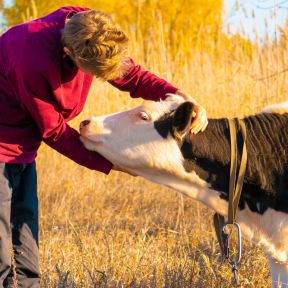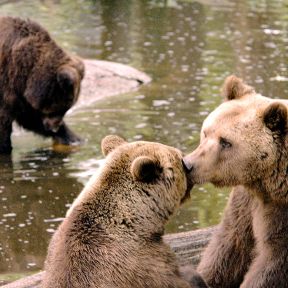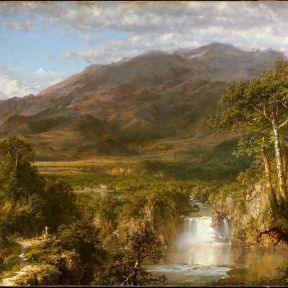
Biophilia
Humans have always been drawn to, dependent on, and fascinated by the natural world. Biophilia, which literally translates to “love of life,” is the idea that this fascination and communion with nature stem from an innate, biologically-driven need to interact with other forms of life such as animals and plants.

Biophilia describes the human drive to connect with nature and other living things. Nature’s power for humanity can influence our mental health, our hobbies, our travels, and our homes and workplaces.
If biophilia delivers benefits to humans, then our increased distance and detachment from the natural world, due to urbanization, technological advances, and other factors, could have negative effects on our well-being—not to mention on nature itself.
The term is thought to have been coined by the renowned psychologist Erich Fromm, but it was popularized by Harvard biologist Edward O. Wilson through his 1984 book Biophilia. In it, Wilson proposed that humans’ attraction to nature is genetically predetermined and the result of evolution.
The human appreciation for flowers, he theorized, was due to the fact that for many plant species, flowers signal that fruit (a rich source of nutrients for early humans) would be arriving soon. And human fondness for baby animals suggests that affiliating with animals, and protecting the most vulnerable among them, provided early people with an evolutionary advantage.
Nature has the capacity to generate wonder and awe. The beauty and expansiveness of nature can lead people to appreciate the grandeur of the universe, put their personal worries into perspective, and be more attentive to their world and their relationships.
Research suggests that the cognitive benefits of being in nature are due to “restorative environments,” which provide the experience of escape from daily demands, and a perception of vastness. Greater attention spans and less mental fatigue are found after people even just watch films or view photographs of natural scenes.
From the lens of evolutionary psychology, people who were well-connected to landscapes, animals, and water sources were more likely to survive. Survival and, later, achievement have rested on creating cohesive non-kinship-based groups. A shared belief in something bigger than the individual can be an effective mechanism for coordination; nature and awe have since united people in creating universities, symphonies, and voyages to the moon.
Freud believed that human existence represented a constant struggle between Thanatos, the death instinct, and Eros, the life instinct. In a healthy human being, Eros retains the advantage in this game of forces.
In a similar way, Erich Fromm analyzed the hidden processes in the human psyche. In the case of Fromm, it is not Thanatos and Eros that confront each other, but rather necrophilia and biophilia. Derived from ancient Greek, “necrophilia” means “love of the dead,” and “biophilia” means “love of life.” Fromm said of human biophilia, “The person who fully loves life is attracted by the process of life and growth in all spheres.”
Research from environmental psychology—the wing of behavioral science studying how natural and man-made spaces affect our health, mental processes, and social interactions—consistently suggests that buildings support us best when they echo the scale and tone of the natural world, through pattern, dimension, light, layout, and sound. An understanding of biophilia can inform design choices that curb stress and boost well-beins. These include wood floors, high ceilings, and plenty of windows.
Biophobia is a fear of nature, or certain elements of nature such as snakes, spiders, or bears. Like biophilia, biophobia has evolutionary roots: Learning which animals and plants were harmful or poisonous protected our ancestors and conferred a higher likelihood of survival. As a species, we continue to fear certain animals or plants, even if it's unlikely that we’ll encounter them in the urban world.

Spending time in nature and interacting with animals can have beneficial effects on both physical and mental health.
Time spent in green spaces, for instance, is associated with lower levels of stress, improved memory, and heightened creativity. Symptoms of ADHD and depression can decrease for children and adults as outdoor time increases. The benefits of green time may be physical, as well: One study concluded that a microbe found in soil may improve the body’s immune response.
Animals are regularly used in therapeutic settings, such as in equine-assisted therapy, and owning a pet has long been associated with positive mental health outcomes. Pets also often encourage physical activity, which triggers its own cascade of physical and emotional benefits.
In addition to inspiring wonder and joy, there is now evidence that time in nature can strengthen mental health. Those who walked in a scenic area experienced less anxiety and rumination than those who walked in a busy urban area, one study found. Longer term research also finds that living in places with more exposure to green space is correlated with lower stress and greater well-being.
Just as there are recommendations for the amount of exercise to get and vegetables to eat, there’s a benchmark for the amount of time in nature needed to boost well-being. Research suggests that that point is two hours per week. That was the time at which nature was associated with better self-reported health and well-being in a large study. That benchmark seemed to hold no matter how the time was spent, whether through one long hike or several short walks in the park.
People who surround themselves with plant life, indoors or out, can experience mental health benefits in many spheres of life, research suggests. These benefits include stress reduction, reduced symptoms of depression, PTSD, and ADHD, stronger memory retention, improved productivity and concentration, greater creativity, and enhanced self-esteem.
Gardening can be a powerful activity. It teaches valuable skills such as accepting uncertainty, confronting perfectionism, being present, connecting to the earth, connecting with other people, and adopting healthy eating and exercise habits. Gardening can also curb stress as well as reduce symptoms of anxiety and depression.
The relationship people form with their pets can bring joy in times of happiness and comfort in times of distress. Pets also facilitate community by leading people to connect with neighbors in the park or strangers on the street. Pets may also provide a buffer against stress and depression: Those with severe depression who adopt a pet fare better than those who are depressed but do not, research suggests. People with dogs also tend to get more physical activity than non-dog owners, which may explain the connection between pet ownership and both stress reduction and heart health.














